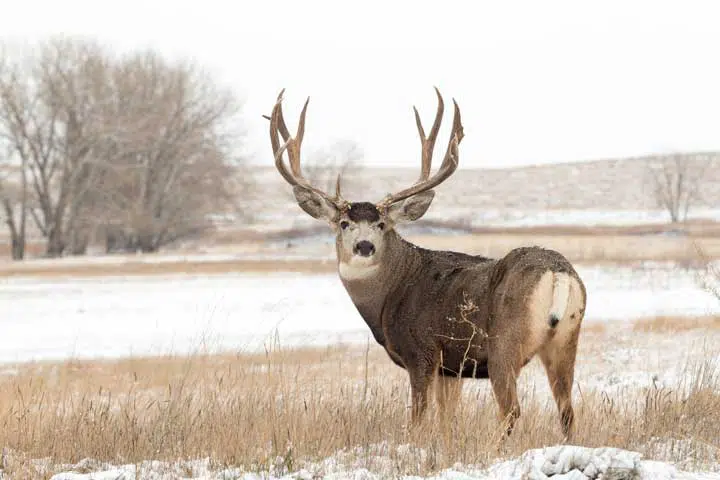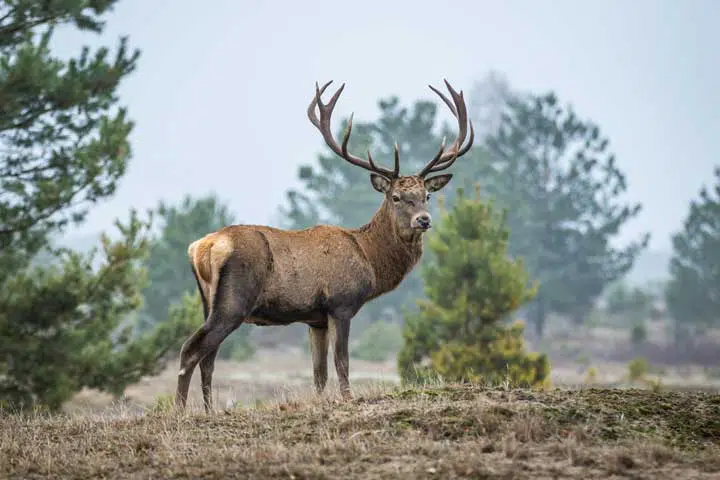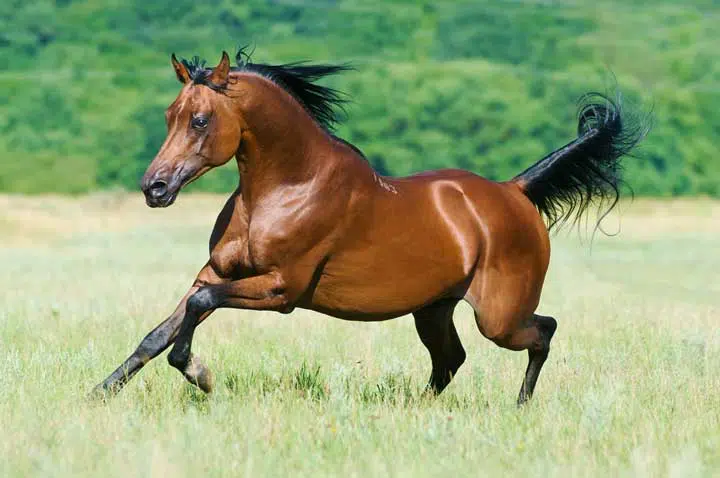Although deer aren’t the fastest animal on land, they can sprint pretty fast. Their swiftness varies slightly depending on the particular species – for instance, research shows that mule deer may be the fastest deer in North America.
Join me in this deep dive into how fast deer can run and whether you, your horse or your dog can outdo these hooved creatures.
Are Deer Fast Runners?
There are numerous species of deer in North America, each living in varying habitats and facing different ecological pressures in their day-to-day lives. Because of their differing environmental contexts, they may have evolved to reach a wide range of speeds while running.
Plus, the speed at which they run will change depending on their reason for running. For example, a deer is likely to run much more quickly when a predator is pursuing it, yet, high testosterone levels might drive a buck to sprint after female deer during mating season, too.
However, casual travel through woodland or across a desert is likely to merit a much more relaxed pace from an individual or a group of deer. Further, a deer is far less likely to run at such high speeds during the winter months. Food is scarce at this time, and the energy costs would be too high, given the minimal supply.
In general, you can catch most deer running at an average speed of 35-40 miles per hour (55-65 km/h). Experts list this as the possible speed for most of the deer population. This means that natural selection has generally resulted in almost any deer’s ability to run this fast, although they might not do it regularly, if at all.
To give you an idea of the deer’s varying physicalities, here are three examples of deer running speeds according to their species.
White-Tailed Deer, Odocoileus virginianus
The white-tailed deer (also known as “whitetail deer”) is a species more common to the eastern half of the United States. Their entire habitat range extends from southern Canada, all the way down to Panama, skipping the western and southwestern regions of the US.
Whitetail deer are gentle giants, standing at an average 3 ft 6 in at the shoulder and weighing in at 203-405 lbs for males and 155-218 lbs for females.
They can carry themselves swiftly across the land, though, reaching speeds up to 35 miles per hour (56 km/h) when they deem it necessary. Normally, though, these animals also move in the following gait patterns:
- Walking
- Trotting
- Bounding
If you’re lucky, you might also come across a deer swimming! During the summer, they may wade into the water to forage yummy plant material.
When it comes to running, though, there are a few things that may scare this deer into a swift sprint. You are one of them!
Humans are a predatory species in the eyes of herbivorous critters like deer, so if you walk into an area and surprise these ungulates (hooved mammals), you’ll give it quite the spook and send it running into the vegetation.
Mule Deer, Odocoileus hemonius

The mule deer is to the western United States what the white-tailed deer is to the East. They live across most of the United States and a significant portion of North America in general, with their most northern habitats reaching the southern Yukon territory. The furthest south the mule deer might travel is to mid-Mexico.
They’re marginally shorter than their white-tailed cousins, reaching 3 ft tall on average. However, they have a slightly heavier average weight, ranging from 154 to 331 lbs.
One might be tempted to think that their heavier weight means they’re relatively sluggish on the run. Yet, researcher Theodore Garland, Jr. had them pegged at nearly 38 miles per hour (70 km/h).
This is one of my favorite types of deer, as the sight of them fills me with nostalgia when I remember off-road adventures in western national and regional parks.
I mentioned earlier that the deer’s body size is interesting to consider when thinking about their running speed. They’re quite heavy and bulky but manage to kick it into high gear at a moment’s notice.
Past research has explored this topic, specifically the intrigue behind the fact that “the largest mammals are not the fastest.” So, there must be an ideal body size to achieve the best speed for their needs, whether for escape, migration, and anything in between.
Interestingly, scientists report that an animal’s maximum running speeds are independent of its mass, as long as it’s within one of these three families:
- Artiodactyla: Also known as the “cloven-hooved” or even-toed ungulates, this family of mammals is home to domestic livestock like sheep and goats, as well as wild animals like antelope and deer, among many others.
- Carnivora: Just as the name sounds, this group contains carnivorous animal species, the fearsome meat-eaters.
- Rodentia: This group’s name sounds similar to its common title, too: rodent. Every little hamster, mouse, gerbil, and similar critters belong here.
So, even though the mule deer is hefty, it can still get pretty fast. So, keep that in mind the next time you’re out hunting one of these guys!
Red Deer, Cervus elaphus

One of the coolest things about the research behind the red deer’s physiology concerning different speeds is that it was originally observed using a treadmill.
Scientists tested the movement of three male deer, weighing about 139, 152, and 161 lbs, on slopes of 7° and 14° to determine their changing oxygen consumption levels.
So, although they weren’t necessarily looking into the animal’s top running speeds, they still gave the hunting and scientific communities a good idea of what this deer can do.
The scientists tested the deer at speeds ranging from about 44.3 meters per minute to 172.9 m per minute. (This converts to about 1.68 mph and 6 mph, respectively.)
The red deer males started galloping at about 120 m per minute, or about 4.5 miles per hour, as they seemed to be uncomfortable sustaining a normal walking pace at that speed.
Unfortunately, it seems that data does not exist on the fastest running speeds specific to the red deer. Still, it’s helpful to know how quickly they can gallop if you’re pursuing one during a hunt.
If you’re unsure of the precise maximum locomotion speed you can expect from a red deer; it’s a safe bet to apply the above estimate of 35-40 mph to this species.
Within North America, you’ll find these deer mostly in California, Texas, and Kentucky. They’re also all over Canada and in Mexico as well.
Which is Faster: A Horse or a Deer?

Planning to go horseback hunting? If so, you might want to get an idea of how fast your horse is capable of traveling before you head out to the backcountry.
One thing you should consider straight away is that your horse is significantly bigger than a deer. Plus, it doesn’t belong to the group Artiodactyla, so the rule mentioned earlier about mass being independent to speed may not apply.
Like the differing deer species discussed above, different types of horses have varying levels of talent when it comes to reaching their top speeds.
Thankfully, lots of research has been done into Thoroughbreds, so we’ve got lots of scientific insight into how fast these animals can truly get.
(I know, odds are you won’t be riding a Thoroughbred when you’re hunting down deer. Still, this information provides a useful baseline to help shape your expectations.)
Firstly, galloping horses can generally reach speeds up to 40 mph (65 km/h). They’re considered to be one of the fastest land animals in the world.
Their gait is powered by their incredible muscles, rippling through their entire body with dense concentrations running through their legs and buttocks. No wonder humans chose them as our go-to steed!
Still, there might be slight variations in their capabilities, depending on breed. For example, Quarter Horses are renowned as the fastest breed of horse worldwide. A study compared these horses’ speed to Arabians and Thoroughbreds and came up with the following results:
- Quarter Horses: 22.3-57.5 mph (36-93 km/h)
- Thoroughbreds: 22.4-52.1 mph (36-83 km/h)
- Arabians: 20.3-33.9 mph (33-55 km/h)
As you can see, Arabians are the slowest of the bunch. Yet, it’s clear as day that horses are significantly faster than deer. So, if your buck gets away, you can trail it, no sweat.
Can a Dog Outrun a Deer?
Another popular practice among hunters is hunting with dogs. Admittedly, this is more common with animals like cougars (e.g., many hunters prefer to tree their cats with a pack of hounds). However, you might still be interested in trying it with deer hunting.
With that said, your dog should be able to run down a deer if you’re going to bring it out to the field. You don’t want a sluggish canine slowing you down.
Just like the other animals discussed here so far, dogs’ speeds vary by breed. Here are some examples of what you can expect from your canine companions:
- Greyhound: 45 mph (72 km/h)
- Vizsla: 40 mph (64 km/h)
- German shepherd: 30 mph (48 km/h)
- Boxer: 35 mph (56 km/h)
The same study that recorded these speeds also stated that, in general, you can expect dogs to sprint between 15-20 mph (24-32 km/h).
However, keep in mind that your dog’s health and fitness will play a prominent role in its physical capabilities. If you don’t exercise your dog often enough, it won’t realize its full potential.
Additionally, think about the terrain. The German shepherd displays moderate speeds compared to the fastest breed, the greyhound. I’ve been running and hiking with one of these shepherds, and the terrain can clearly be a significant barrier to the dog’s ability to reach top speeds.
For instance, if you’re hunting out on the open plains, it’ll be much easier for your dog to run fast. There are no trees or other natural obstacles to navigate, and the ground is probably not too rocky, so it’s easy to get a grip and travel across the surface.
However, imagine you’re in a mountainous area, full of rock outcroppings and tree stands as far as the eye can see. In this case, you and your dog are going to have a hard time getting a good amount of momentum going.
All in all, your dog should be able to keep up with a deer pretty easily if you need it to chase one down for you.
Can You Outrun a Deer?
Now, on to you. Are you curious if you, a human, can outrun a deer? Let’s say you don’t have a horse or a dog with you, but your buck ran away with the first shot.
Now, I wouldn’t necessarily recommend chasing it down, but that’s a discussion for another day. But, let’s say you tried to run after it. Would you be able to catch it?
The answer is simply no. I know, disappointing. As one of our many weaknesses compared to other land mammals, humans are pretty slow. Unfortunately, not all of our kind can live up to the likes of Usain Bolt, who can cover a distance of 100 m in only 9.58 seconds.
Yet, in scientists’ inquiries into humans’ maximum speed, they’ve brought up an interesting topic: bipedal vs. quadrupedal running. Yes, you read that right – it’s possible that humans can run faster on all fours! One study’s results suggested that “in the future, the fastest human on the planet might be a quadrupedal runner at the 2048 Olympics.”
Right now, studies show that humans’ top speed falls somewhere around 28 mph (45 km/h).
Embarrassingly, that makes us slower than most other terrestrial mammals, including rabbits. That said, you have little hope for outrunning a deer, whether you’re trying to chase it down or get away from the one you’ve ticked off.
Although, if it makes you feel better, you can outrun squirrels, chickens, snakes, turtles, and bugs!
The funny thing about the study that concluded 28 mph (45 km/h) as the max human speed is that it was tested over short distances. So, the researchers warned that it likely overestimated each animal’s speed. Still, here’s to hoping that humans get faster over time.
Speed and Blood Loss
If you are out hunting, there will come a time where your shot is off or not enough to kill the deer right away. Tracking becomes a necessity, but the deer took off through the woods, and they can still travel quickly. Up to 35 miles per hour (56 km/h)!. However, that movement will cause increased blood pressure, which will lead to a decrease in blood supply over time if it’s fatal. Sometimes it is not, and the blood can be misleading.
Often hunters will want to be careful when a herd of deer is nearby as they help to conceal where your deer has been if they become scared and dart around.
Conclusion
Deer are surprisingly speedy creatures, typically reaching 35-40 miles per hour (56-64 km/h) when they really get going. Although you won’t be able to outrun one (unless you’re Usain Bolt or exceptional at running on all fours), a dog or horse can.
The next time you’re preparing to go hunting, refer back to this overview to remind yourself what you’re up against if your buck sees you before you see it.




